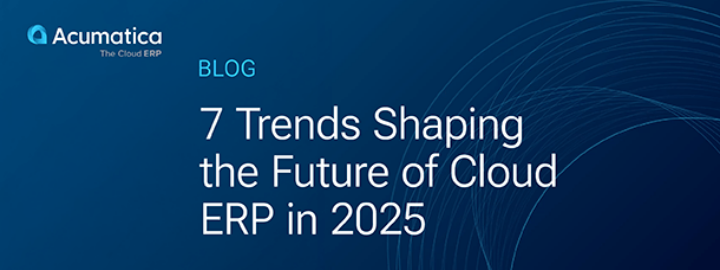
Acumatica’s VP of Solution Architecture, Doug Johnson—who, until recently, served as the VP of Product Management—discusses the Acumatica product evolution, how ERP architecture has changed over his 16-year career at Acumatica, and what customers can expect from AI in the coming years.
Tell us about your career journey and what led you to Acumatica.
I started at AT&T, but I wanted to get a job outside of telecom where I could have more influence on how things worked. So, I worked for a software company called Parallels where I met Mike Shchelkonogov, who is now Acumatica’s CTO. We worked together on a financial and billing solution for hosting providers. I was his marketing and sales person; he was a developer and product person. When Mike started working on the Acumatica platform, it seemed logical for him to contact me and ask if I would like to help take something else to market.
So, that led me to Acumatica, and a couple of months later, in August of 2008, I was officially onboard.
You’ve been at the center of Acumatica’s product evolution. What are some highlights that stand out for you?
In the beginning, the platform was designed as web-based software—using a browser to access data. The founders knew that this was the direction software was going. A web-based financial platform was a critical foundation for a configurable ERP solution. Seeing that happen was a highlight for me.
Another highlight was related to why partners were attracted to the platform. It was very versatile. Of course, every ERP company says their platform is versatile, but ours was designed with partners in mind. We built it so that a business process expert—not a developer—could take what was there and configure it—not customize it, but configure it—to work for their particular clients. Over the years, we’ve kept adding more and more and more to the platform. In Acumatica 2024 R1, we previewed the new user interface, and, in 2024 R2, we’re getting even closer to it. And by 2025 R1, people are really going to love what they see in the new UI.
You’ve been part of the product team for some time. How will that deep product knowledge help you in your new role as VP of Solution Architecture?
I’m working with the Acumatica Presales Team, but we’re evolving to becoming a Solution Architecture Team. Acumatica’s flexibility means it can be implemented at the same company multiple ways. To pick which way is best, you need to understand everything about what that company does today, and you need to have a crystal ball into the customer’s current pains and future plans. The product knowledge and product roadmap that I was working on while on the Product Management Team are really important for this. In my new role, I can look at the crystal ball alongside the Acumatica product vision and give customers advice based on my double knowledge: my knowledge of their future vision for their company and my knowledge of where the Acumatica product is going. For instance, if they’re planning to build a lot of workflows and customizations, I can say: “Don’t do that because it’s all going to be part of something you can easily do in the new Acumatica UI. If you can do a really simple workaround for the next six months, we’re going to get there, and you’ll be able to accomplish what you want to accomplish with a much smaller investment.” That kind of product knowledge is going to help me and everyone else on the Architecture Team.
What changes have you seen in ERP architecture during your time at Acumatica and over your career?
When I first started at Acumatica, we were trying to convince people that the cloud is a good thing. Now, the software landscape has converted to SaaS. Over my career, I went from writing articles about why you should be using the cloud and a SaaS solution to realizing that people had gotten it. Then, I switched my focus to why you should be using Acumatica, why the platform is important, why RESTful APIs are important, why AI and ML and other upcoming technologies are important. So, that was the big change I’ve seen in ERP architecture. Of course, Acumatica had it right from the get-go, but the rest of the world has now realized the importance of the cloud.
What do you think is the most important focus or mindset when developing new products and services for global markets?
Some technology companies build solutions for the technology’s sake. They build something that’s cool, and maybe somebody will like it. Others build technology with sales in mind. They build whatever is going to get them the easiest sale at a given point—which leads to zig-zagging product development, where they build one thing to chase one deal and then build something different to chase another. Instead, it’s important to have a good target audience in mind—developing products for a specific, underserved segment. A prime example of this is our Construction Edition. We saw that many construction companies were using older, antiquated systems. We focused on the construction market and what it needed, and we were able to roll out a specific architecture and package for a specific group of customers.
Artificial intelligence is seen as the future of technology. How has AI helped shape business solutions development, and what can customers expect in the coming years?
You could argue that AI has existed forever. At the core, AI takes a bunch of data, analyzes it, and produces results. We’ve had that ability since people started storing data. What’s changed is the amount of data available and the processing power behind it. We have evolved from things like anomaly detection and pattern recognition to large language models (LLMs) that can digest huge amounts of public information and use that data to create “original” content.
What’s lacking is the value our customers—who are small and medium-sized businesses—would get from using AI on their own data. LLMs have access to all this public data, and giving them access to your particular data would make them valuable for you. But there’s a problem with that. You have a lot of security policies that govern who can see and who can’t see your data. So, imagine giving your data to an engine that breaks it into smaller pieces—vectors—and, in the process, all your security policies get lost. Now, you’ve got this big chunk of data with some of your stuff filtered into it. The AI is off writing its stuff, but all your security policies went out the door.
So, we have to be careful. And that’s why we developed the Acumatica Principles of Innovation. Any process built with AI has to be simple, cost effective, and responsibly developed. If it’s too complicated or too expensive, nobody is going to use it. And, if it isn’t responsibly developed, then, like I said, your security policies can be stripped. It’s not going to go over well when the first person to find out about your corporate results is the AI engine that spreads it out to the world.
The customers I’ve spoken with are happy that we’re a forward-looking company and that we’re working with emerging technologies, but they’re also happy to hear that we have principles behind what we’re doing.
Do you have any advice for companies interested in using ERP technology to grow their businesses?
I’ve seen things from the product side. I’ve seen things from the sales and marketing side. And now I’m back in solution architecture. And, from that experience, I have three pieces of advice to give.
First, understand your business and where it’s going. Understand the goals of your own business and where you are going to be in three to five years. Make sure that you’ve defined your business requirements before you start making ERP decisions.
Second, involve the entire organization in the ERP selection process because no single person can know your company’s end-to-end processes completely.
Third, don’t overlook the ERP implementation plan. Pick what’s realistic and make timelines for when you’re going to get it done.
 Canada (English)
Canada (English)
 Colombia
Colombia
 Caribbean and Puerto Rico
Caribbean and Puerto Rico
 Ecuador
Ecuador
 India
India
 Indonesia
Indonesia
 Ireland
Ireland
 Malaysia
Malaysia
 Mexico
Mexico
 Panama
Panama
 Peru
Peru
 Philippines
Philippines
 Singapore
Singapore
 South Africa
South Africa
 Sri Lanka
Sri Lanka
 Thailand
Thailand
 United Kingdom
United Kingdom
 United States
United States











